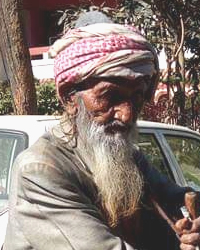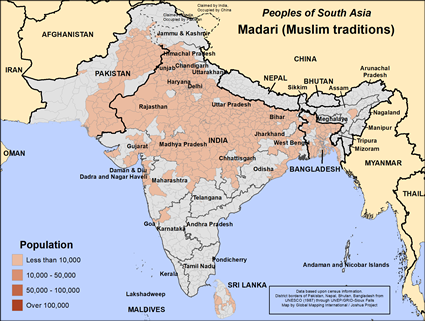Most Madari people live in India and Pakistan. Smaller groups live in Bangladesh and Sri Lanka.
The Madari people were originally all Hindus but many converted to Islam during the period of the Moguls. Their traditional occupation is that of being snake charmers and entertainers with monkeys and bears.
With the rise of animal rights, the Madari have had to find other employment. Many have left their nomadic habits to settle down to become farm workers and day laborers. The vast majority of Madari are landless. Some of their women and children beg to gain income to support their families.
The Madari marry within their caste but not within their particular clan. Families arrange marriages. The newly married couple lives near or with the groom's parents. Often the groom's young man must live and work for his future father in law as part of the bride price. The family must compensate the bride's family for the daughter they are losing. Sons inherit property from their father.
In the past, most Madari traveled from village to village entertaining other castes with snake charming and trained animals. Most now live in rural villages making a living by working on land owned by others. Caste councils or "panches" decide legal disputes especially those involving marriage and divorce.
The main foods of the Madari are rice, millet, wheat and vegetables. They will eat meat on special occasions but not pork or beef. Alcoholism is a problem for the Madari, even though alcohol is forbidden to Muslims.
The Madari people are Sunni Muslims. Some practice the mystical branch of Islam called Sufism. Islam is a major world religion that is based on five essential duties or "pillars": (1) A Muslim must affirm that "there is no god but Allah and Mohammed is his prophet." (2) Five times a day one must pray while facing Mecca. (3) One must give an obligatory percentage (very similar to tithes) on an annual basis. (4) One must fast during Ramadan, the ninth month of the Muslim year. (5) One must try to make at least one pilgrimage to Mecca in his or her lifetime.
The two main holidays for Sunni Muslims are Eid al Fitr, the breaking of the monthly fast and Eid al Adha, the celebration of Abraham's willingness to sacrifice his son to Allah.
Illiteracy is a big problem for the Madari. As long as most of the Madari cannot read or write, they will remain at the bottom rung of society. The main language of the Indian Madari is Urdu.
Pray that the Lord sends believers to build relationships with the Madari people.
Pray for the Holy Spirit to give the Madari people teachable and understanding hearts.
Pray for Jesus movements to bless extended Madari families so the gospel will spread rapidly among this people group.
Pray for a strong movement of the Holy Spirit to bring entire Madari families into a rich experience of God's blessing.
Scripture Prayers for the Madari (Muslim traditions) in India.
https://en.wikipedia.org/wiki/Madari
| Profile Source: Joshua Project |











